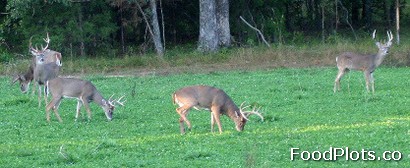One of the best ways to ensure that the deer on your property get all the nutrition that they need is to provide food plots for whitetail deer. You can also provide supplemental food in the form of protein pellets, but successful food plots are less expensive than sacked feeds. Food plots for whitetail deer should comprise about two to five percent of a of the area involved in deer management. This acreage includes both spring (warm season) and winter (cool season) food plots.
Many landowners and hunters may think that bigger food plots are better than smaller ones, but the opposite is true. Deer prefer smaller plots, but it takes more work to plant a bunch of small plots versus one big one. Additionally, research has shown that as little as one percent of the property planted to high quality spring and winter food plots can produce substantial, measurable benefits to whitetail deer. For maximum production, it’s important to have the right equipment and learn how to plant food plots and manage each of the plots within a complex of plantings.

First, make sure you properly prepare your field for planting, and this includes getting a soil test. In addition, it is important to plant spring and winter plots in different fields or at least in different sections of the same field (ie. 50:50 split). It is important that hunters interested in deer management and providing supplemental food do not take away available foods in preparation for future food plots. In short, leave a growing plot in place and plant the next season’s plot adjacent to it or in a different plot altogether.
A good plant to seed to spring food plots is iron and clay cowpea. This plant provides nutritious forage until the first frost, which varies depending on where your property is located, but will last well into November at southern latitudes. However, many hunters in the south begin planting winter food plots in early September. Disking over cowpeas in order to plant plots for the fall would have prevented at least two good months of growth.
Most food plots for deer end up being somewhere between 1/4 and three acres in size. Again, numerous smaller plots are more beneficial than fewer larger plots because several smaller food plots can be spread out over the whitetail deer management area. This gives more deer access to the plots and benefits more whitetail on your property.
The limiting factors for the minimum and maximum size of food plots ultimately end up being the amount of shade, whitetail deer density and the distance to habitat providing cover. Food plots should be large enough and wide enough to allow most plantings a minimum of four hours of direct sunlight each day. If foods plots are over-browsed by deer, then additional or larger food plots, habitat management or increased deer harvest should be considered.
Ideally, food plots should be located near travel corridors where whitetail deer normally travel. Look for areas where two or more vegetation types come together, such as where mixed woodlands and fallow fields or native grasslands meet. Keep in mind that whitetail always like to be near screening cover. For deer hunting purposes, whitetail will rarely used areas in food plots during daylight hours that are located more than about 150 feet from cover.
Spring-Summer Food Plots for Whitetail Deer
Spring and summer food plots for whitetail deer provide the energy needed for lactation, fawn growth and antler growth in bucks. Warm season food plots are great places to deer hunt during the early season, especially before acorns and cool season forbs become available. Spring plots should be planted late enough to avoid the last frost but early enough in the year to take advantage of spring rains.
There are lots of choices when it comes to warm season food plots. Soybeans are probably the all-time favorite spring and summer food plot of whitetail deer, but they do not hold up well to heavy browsing pressure, especially when plants are young and vulnerable. Though a great forage, soybeans should only be planted on properties with low deer densities. Otherwise, the food plot will not be allowed to grow and provide the nutrition deer will need throughout the summer.
Iron and clay cowpeas, as mentioned previously, provide high quality spring and summer food plots for deer, especially in late summer through the early fall when habitat is usually in poor condition. Lab lab is also an excellent choice in the spring. Both iron and clay cowpeas and lablab stand up to browsing pressure well, and they can be planted on a wide variety of soils. Fields located in bottomlands can have the seeds of American jointvetch, alyceclover and brassicas added to the food plot seed mix. It is recommended that food plots always contain at least two plant species. For more information, check additional articles on spring and summer food plots or winter food plots to help you better manage the whitetail deer found on your property.